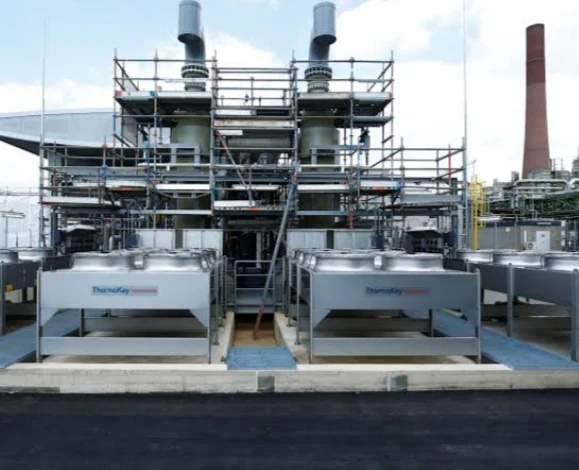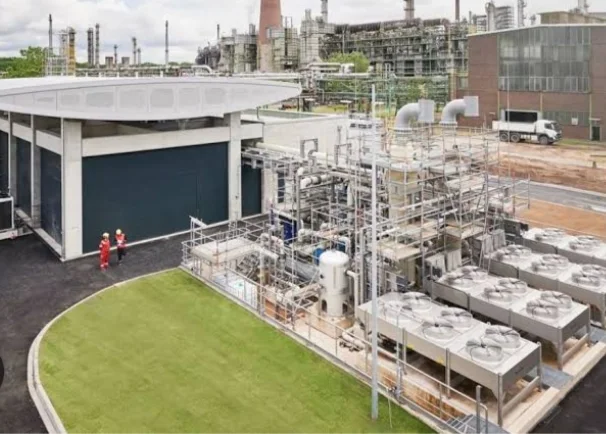What is Alkaline Electrolysers?
Alkaline electrolysers (AELs) are a type of technology used to split water molecules into hydrogen and oxygen using electricity.
They're essentially like electrochemical batteries in reverse, where you provide electricity to break down water instead of using a chemical reaction to generate electricity.
Here's a breakdown of how they work:
Inside an AEL:
- Electrolyte: Imagine a tank filled with a strong alkaline solution, typically potassium hydroxide (KOH). This acts as the conductor for electricity within the cell.
- Electrodes: Two electrodes, an anode and a cathode, are immersed in the electrolyte but separated by a porous membrane.
- Electricity applied: When you supply electricity to the electrodes, something magical happens!
- At the cathode: Water molecules (H₂O) react with electrons to form hydrogen gas (H₂) and release hydroxide ions (OH⁻).
- At the anode: The hydroxide ions migrate through the membrane and react with water to form oxygen gas (O₂) and take up electrons.
The result: Split water, clean hydrogen gas, and oxygen gas as a byproduct!
Advantages of AELs:
- Mature technology: They've been around for a long time, making them well-established and readily available.
- Cost-effective: Lower upfront costs compared to some newer technologies due to simpler design and materials.
- Durable and reliable: Can operate for long periods with minimal maintenance, ideal for industrial applications.
- High purity hydrogen: The electrolyte effectively separates hydrogen and oxygen, resulting in clean gas for various uses.
- Flexible: Adapt to fluctuating renewable energy sources by operating across a wide range of power input levels.
Challenges of AELs:
- Lower efficiency: Convert less electricity into hydrogen compared to some newer technologies.
- KOH degradation: The electrolyte solution can degrade over time, requiring replacement and adding to costs.
- Limited operating temperature: Operate at lower temperatures, affecting efficiency and hydrogen production rate.
Alkaline Electrolysers: Powering the future with green hydrogen
Alkaline electrolysers (AELs) are veterans in the field of hydrogen production, boasting a century-long history of splitting water molecules into clean-burning hydrogen and oxygen. Today, they're experiencing a resurgence as a key technology for generating green hydrogen, powered by renewable energy sources like solar and wind.
Here's a deep dive into the world of AELs:
How they work:
AELs function like electrochemical batteries in reverse. Imagine a tank filled with potassium hydroxide (KOH) solution, the electrolyte. Two electrodes, an anode and a cathode, are immersed in this solution, separated by a porous membrane. When electricity is applied, water molecules at the cathode get split, releasing hydrogen gas. Meanwhile, at the anode, oxygen molecules form and bubble away.
Advantages of AELs:
- Mature technology: AELs boast a long history, translating to well-established manufacturing processes and a readily available supply chain.
- Cost-effective: Compared to other electrolyzer technologies, AELs typically have lower upfront costs due to less complex materials and simpler designs.
- Durable and reliable: AELs can operate for extended periods with minimal maintenance, making them suitable for industrial applications.
- High gas purity: The alkaline electrolyte effectively separates hydrogen and oxygen, resulting in high-purity gas streams.
- Flexibility: AELs can operate across a wide range of power input levels, adapting to fluctuating renewable energy sources.
Challenges and considerations:
- Lower efficiency: Compared to newer electrolyzer technologies like proton exchange membrane (PEM) electrolyzers, AELs exhibit slightly lower electrical-to-hydrogen conversion efficiency.
- KOH degradation: The electrolyte solution can degrade over time, requiring periodic replacement and adding to operational costs.
- Limited operating temperature: AELs typically operate at lower temperatures compared to PEM electrolyzers, which can affect their efficiency and hydrogen production rate.
The future of AELs:
Despite the challenges, AELs continue to play a crucial role in the green hydrogen revolution. Research and development efforts are focused on improving efficiency, extending lifespan, and reducing operational costs. Additionally, large-scale deployment projects are demonstrating the feasibility and economic viability of AEL technology.
AELs offer a mature, cost-effective solution for producing green hydrogen from renewable energy sources. While they face competition from newer technologies, continuous advancements and large-scale deployment hold promise for a bright future in the clean energy landscape.
Frequently Asked Questions about Alkaline Electrolyzers
Alkaline electrolyzers are a common type of electrolyzer used to produce hydrogen gas from water. Here are some frequently asked questions about them:
General Questions
- What is an alkaline electrolyzer? It's a device that uses an electric current to split water molecules into hydrogen and oxygen gases.
- How does it work? An alkaline electrolyzer uses a potassium hydroxide (KOH) electrolyte to facilitate the electrolysis process. The electric current causes water molecules to dissociate at the electrodes, producing hydrogen gas at the cathode and oxygen gas at the anode.
- What are the main components of an alkaline electrolyzer? The primary components include electrodes (anode and cathode), electrolyte, separator, and cell housing.
Advantages and Disadvantages
- What are the advantages of alkaline electrolyzers?
- Mature technology: Alkaline electrolyzers have been around for decades and are well-understood.
- Lower cost: They generally have a lower capital cost compared to other types of electrolyzers.
- Higher tolerance to impurities: They can tolerate impurities in the feedwater better than some other types.
- What are the disadvantages of alkaline electrolyzers?
- Lower efficiency: They typically have lower energy efficiency compared to newer technologies like PEM electrolyzers.
- Larger size: Alkaline electrolyzers tend to be larger and require more space.
- Higher electrolyte concentration: They require a higher concentration of electrolyte, which can be corrosive and requires careful handling.
Applications
- Where are alkaline electrolyzers used?
- Hydrogen production: For various applications, including hydrogen fuel cells, chemical synthesis, and industrial processes.
- On-site hydrogen generation: For applications that require a reliable and local hydrogen supply, such as refueling stations for hydrogen-powered vehicles.
- Power-to-gas: To store excess renewable energy as hydrogen.
Comparison to Other Types of Electrolyzers
- How do alkaline electrolyzers compare to PEM electrolyzers?
- Efficiency: PEM electrolyzers are generally more efficient.
- Cost: PEM electrolyzers have higher capital costs but may have lower operating costs due to higher efficiency.
- Operating conditions: PEM electrolyzers operate at higher pressures and temperatures.
- How do alkaline electrolyzers compare to solid oxide electrolyzers (SOECs)?
- Efficiency: SOECs have the potential for higher efficiency.
- Operating temperature: SOECs operate at very high temperatures, requiring specialized materials and more complex systems.


